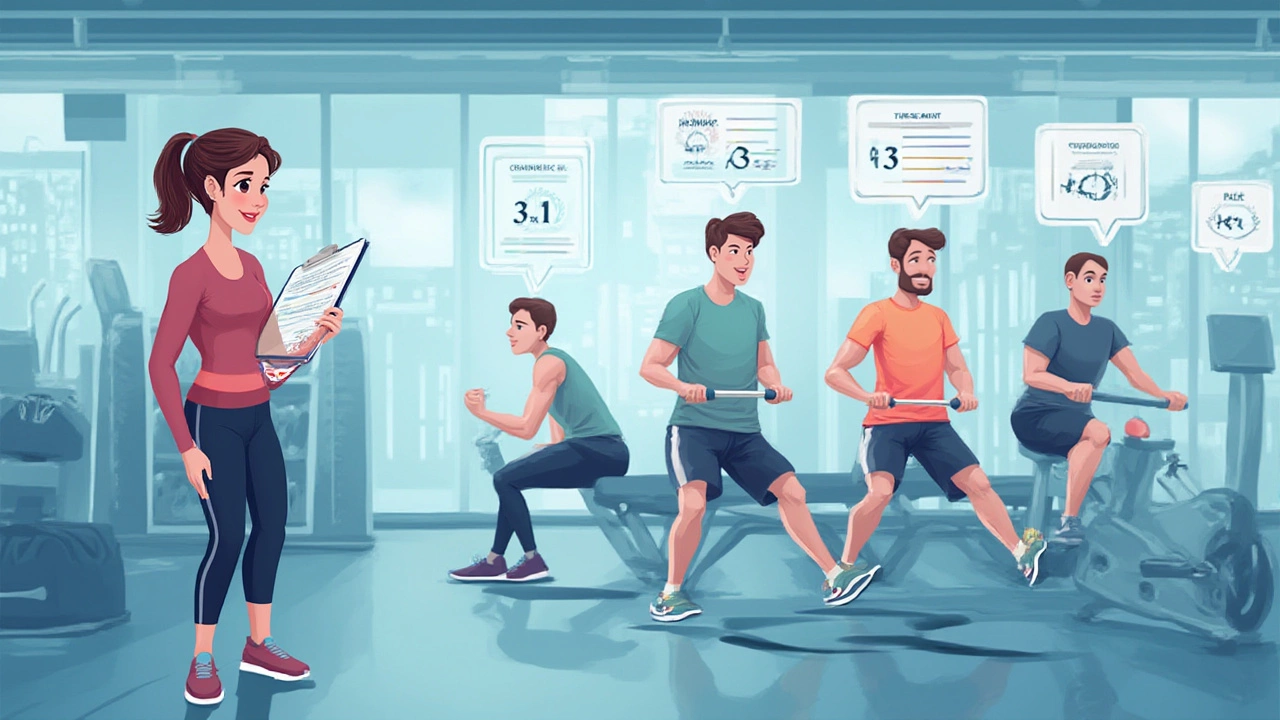Best HIIT Workouts: Which Type Gets Results Fast?

There’s something wild about the promise of HIIT: get fitter, leaner, and stronger in a fraction of the time you’d “waste” on long, droning runs. People swear by it, and science keeps backing up the magic mix of short, sharp bursts paired with catch-your-breath breaks. But ask five trainers about the most effective form of HIIT, and you’ll get double the answers. Some love treadmill sprints, others push for burpee circuits, and a few ride the assault bike like it’s a ticket to Valhalla. Truth? Not all HIIT is created equal, and the devil’s in the details.
Why HIIT Stands Out: Science, Sweat, and Surprises
HIIT (High-Intensity Interval Training) isn’t just another gym trend—it’s hands-down one of the most-researched fitness methods out there. Most forms of HIIT ask you to push close to your max for 20-60 second blasts, then recover for a short window before going again. Here’s the kicker: pushing so hard actually spikes your heart rate, floods you with endorphins, and trashes calories long after you leave the gym. That “afterburn” is officially called EPOC (excess post-exercise oxygen consumption), and scientists at the University of New South Wales reported you can burn up to 30% more calories, even after you’ve finished working out. HIIT isn’t just about burning calories, though—it’s linked to improved insulin sensitivity, heart health, and increased muscle, especially compared to traditional slow-and-steady workouts.
There’s a solid mix of HIIT routines, from bodyweight-only burners to those that rely on machines or weights. The real “magic” comes down to pushing near your absolute limit, not just feeling a bit puffed. In fact, proper HIIT means you almost dread the next interval—it’s tough, uncomfortable, and you need real recovery between rounds. The more you actually hit this threshold, the juicier the results: think faster changes in aerobic fitness, sharper muscle definition, and that strong-afterburn effect. But there’s a fine line—too much or too little intensity, and you’ll just plateau or accidentally just do a regular workout that’s a bit harder to breathe through. Whether you’re after fat loss, better stamina, or simply time-efficiency (which, let’s face it, with my cat Nimbus often demanding attention, really matters), picking the right HIIT style is crucial.
The Contenders: Battle of the Best HIIT Styles
Not all HIIT is cut from the same cloth—some routines focus on pure speed and power, others on cranking the heart rate with compound moves. Most studies, and many coaches I trust, agree on a few main types worth digging into:
- Sprint Intervals (Running or Cycling): Classic, brutal, very science-backed. Think 30 seconds all-out effort, then 1-3 minutes rest—repeat 4-8 times. Research from the British Journal of Sports Medicine found this form of HIIT improves VO2 max (a marker for aerobic fitness) more than steady-state cardio. Cyclists at Loughborough University showed big drops in body fat after just six weeks of these intervals.
- Tabata: The wild child of HIIT. Designed by Dr. Izumi Tabata for Olympic athletes, it’s just 4 minutes: 20 seconds all-out, 10 seconds rest, 8 rounds. It sounds “easy” until you try it properly—pick one move (like burpees, squats, or jump lunges) and pour your soul into it. Studies show Tabata can lift both aerobic and anaerobic capacity in record time. But for most of us mere mortals, one Tabata circuit isn’t quite enough for general fitness or fat loss—you may want to combine a few Tabata rounds with rests between for balance.
- Bodyweight Circuit HIIT: This is for anyone who hates monotony. You string together tough moves like mountain climbers, jump squats, push-ups, and plank jacks—30 seconds on, 10-30 seconds off, up to 25-30 minutes total. It still smashes your heart rate, and you’ll work multiple muscles at once. A big plus is the “no equipment” angle—easier to fit into a busy day, even at home.
- Hybrid Machine HIIT (Rowing, Air Bike, SkiErg): These let you work both upper and lower body at once, and their display consoles make tracking intervals easy. Assault bike sprints: 20 seconds full-out, two minutes gentle, repeated 8-10 times, are notorious for destroying even the fittest athletes. Rowing HIIT, in particular, excels for low-impact but all-body benefits.
This all sounds great in theory… but which is “best”? If you chase pure fat loss, studies published in Obesity Reviews suggest sprint-based intervals (running or cycling) edge ahead, especially for shaving abdominal fat. For boosting overall fitness and building muscle, bodyweight HIIT circuits are more adaptable and strike a broader balance. If you want efficiency and hate long workouts, nothing rivals the Tabata protocol—though its effectiveness hinges on true, teeth-gritted maximums.
| HIIT Style | Best For | Session Length | Scientific Support |
|---|---|---|---|
| Sprint Intervals | Fat loss, heart fitness | 10-20 min | Extensive |
| Tabata | Efficiency, fat loss | 4-12 min | Strong |
| Bodyweight Circuits | General fitness, variety | 20-30 min | Good |
| Hybrid Machine (Row/Air Bike) | Whole-body benefits | 15-25 min | Very strong |

Making HIIT Work: Practical Tips and Pitfalls
If you’re tempted to jump in, a few pointers can make or break your HIIT experience. First, don’t mistake “fast paced” for “truly intense”—going through the motions won’t trigger the big perks. Each work interval should push you to 85-95% of your maximum heart rate. If you finish an interval and could chat about the weather (or, in my experience, could still chase Nimbus as he darts up the stairs), you’re probably not pushing hard enough.
Form matters more than speed. You’re far more likely to trash your knees (or back) if you lose form in the excitement, especially on moves like jump lunges or explosive push-ups. Slow down for a sec to get it right. Mix up the exercises every week or two. Beyond boredom, doing the same interval and move over and over means your body adapts and stops improving. Don’t skip warm-ups—jumping straight from your desk chair to max-effort burpees is a surefire way to tweak a muscle. I like five minutes of dynamic moves: high knees, inchworms, maybe a few gentle cat-cow stretches (Nimbus sometimes joins in for this part).
If you’re just starting out, aim for 1-2 sessions a week. Recovery is key—more isn’t better! Elite sprinters, for example, rarely repeat true HIIT more than three times a week, just because of how taxing it is on your nervous system and muscles. Mix intervals with walks or lighter forms of cardio if you need to move more often.
Tracking helps. Use a heart rate monitor if you can, or the “talk test”—can you manage more than one or two words per breath at peak intensity? If yes, not intense enough. And don’t skimp on recovery. If you can’t keep the effort up for remaining intervals, that’s a sign more rest or shorter sessions will help you long-term.
HIIT Workouts to Try: Varied, Effective & Fun
Ready to go? Here are a few sample routines based on evidence-packed protocols. Tailor these to your own fitness and kit at hand—you don’t need fancy equipment to reap huge benefits!
- Classic Sprint HIIT (running or cycling):
* Warm up 5 minutes – gentle jog or easy spins * Work: 40 seconds all-out sprint * Rest: 2-3 minutes walking or easy pedaling * Repeat 6 times * Cool down and stretch - Tabata Bodyweight Circuit:
Perform 1 Tabata round for each move, resting 1 min between rounds: * Jump squats: 20 sec on, 10 sec off x 8 (4 mins) * Push-ups: 20 sec on, 10 sec off x 8 (4 mins) * Mountain climbers: 20 sec on, 10 sec off x 8 (4 mins) - Rowing/Bike HIIT:
* Warm up 5 mins * 30 sec max effort, 90 sec easy pace: 8 rounds * Cool down for 3 mins - Simple Home Circuit:
* 45 sec squats, 15 sec rest * 45 sec push-ups, 15 sec rest * 45 sec skipping/no skipping rope, 15 sec rest * 45 sec alternating lunges, 15 sec rest * Repeat circuit 3-5 times
Crank your music, set a timer, and let your effort set the pace. The more consistently you challenge yourself, the quicker you’ll spot the changes—improved energy, sharper mood, and yes, plenty more stamina for chasing pets, catching buses, or just smashing daily life. The real secret? The most effective HIIT is the one you push hard, enjoy (a bit), and stick with—not just the trendiest protocol you read about online.